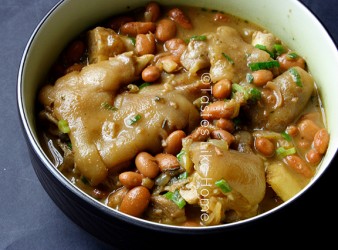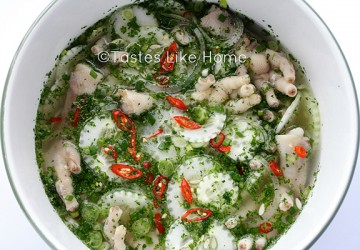Hi Everyone,
I love feet, that is, chicken feet, pig’s feet and cowheel. Some of you may know them as steppers, trotters, and cow foot.
Why do I love them? Oh, let me count the ways.
First is the soft gelatinous texture that results from the very low, slow cooking. The long cooking breaks down the tissues, muscles, and tendons and renders them so soft that they slip, slide and slither across your tongue. Chewing becomes a game you play with the food in your mouth as you try to bite down on the pieces of “meat”. The cheapest of cuts become the most delectable of foods.
There is really no meat per se with chicken feet, pig’s feet or cowheel; these cuts are made up of bone, cartilage and tendon. When cooked, it is the cartilage and tendon that becomes the “meat” that we lovers of feet enjoy so much. The bones release their marrow and collagen and it is in these substances that we find the most abundant protein of the animals.
Many of our Caribbean dishes are steeped in history, class and culture. Souse, pig trotters stew and cowheel soup all find a place of prominence in the story of our food, of which there are many threads. The use of feet in many of our traditional dishes is as a direct result of what was left back and given to the slaves after the plantation owners would take the “best” parts of the animals for themselves.
They (slaves) had to contend with the head, feet, tail, internal organs and skin. Bone marrow and collagen found in these other parts of the animals can be considered early super-foods, not only do the feet themselves contain an abundance of protein but other nutrients such as calcium, phosphate and magnesium can also be found in cooked animals’ feet.
Caribbean food is complex and it is often considered as “other” and “ethnic”. When it gets portrayed on the world stage, it does so as a flourishing garnish. When any dish is actually made, it is always done with ingredients and in a manner that is considered ‘safe’ and ‘palatable’ to a mass audience. The version of Caribbean food presented lacks the nuances of the cuisine.
 I like the texture and flavour that feet give to whatever the liquid in which it is cooked. Stews, soups and pickles all become thick and silky. Do you notice how the sauce of Pepperpot becomes thick after a couple days of boiling and clings to the bread when mopped up? One of the many reasons I enjoy Pepperpot is simply because it has in cowheel and trotters. I don’t care much for the actual meat in the dish, just gimme my bones, tendons and skin.
I like the texture and flavour that feet give to whatever the liquid in which it is cooked. Stews, soups and pickles all become thick and silky. Do you notice how the sauce of Pepperpot becomes thick after a couple days of boiling and clings to the bread when mopped up? One of the many reasons I enjoy Pepperpot is simply because it has in cowheel and trotters. I don’t care much for the actual meat in the dish, just gimme my bones, tendons and skin.
Yet another thing I like about feet is the ways in which they can be cooked – pickled (soused), stewed or boiled in soups.
The cooking and eating of feet is not only well known in the Caribbean, it is also cooked and eaten in Africa and China. Whenever I travel overseas and seek out Dim Sum restaurants, it’s not because of the myriad of dumplings (though they are good!); I seek out the chicken feet, beef tendon and tripe. I remember the first time I pointed and asked a server (as she the rolled the trolley up to my table) for the chicken feet and how surprised she was. I mean it was not just a facial expression but her body moved, she literally pulled back her head and shoulders too, she smiled and handed over the bamboo steamer that held the plate with the chicken feet. The next time she came around, she simply stopped the trolley and opened one of the steamers with the beef tendon and another with tripe. She had me pegged; I didn’t just want the stuff they made for Americans. I smiled and nodded. Life could not get any better (LOL).

There are many dishes all around the world that use various animal feet in their cooking. In France they roast pig’s feet and serve them with béarnaise sauce (a rich sauce thickened with egg yolks and flavoured with tarragon) and fries! Israelis use kosher cowheel to make an old Jewish dish called Ptcha. Think of it like head cheese or congealed souse.
I’m off now to have some Chicken Foot Souse with boiled green bananas.
Cynthia










